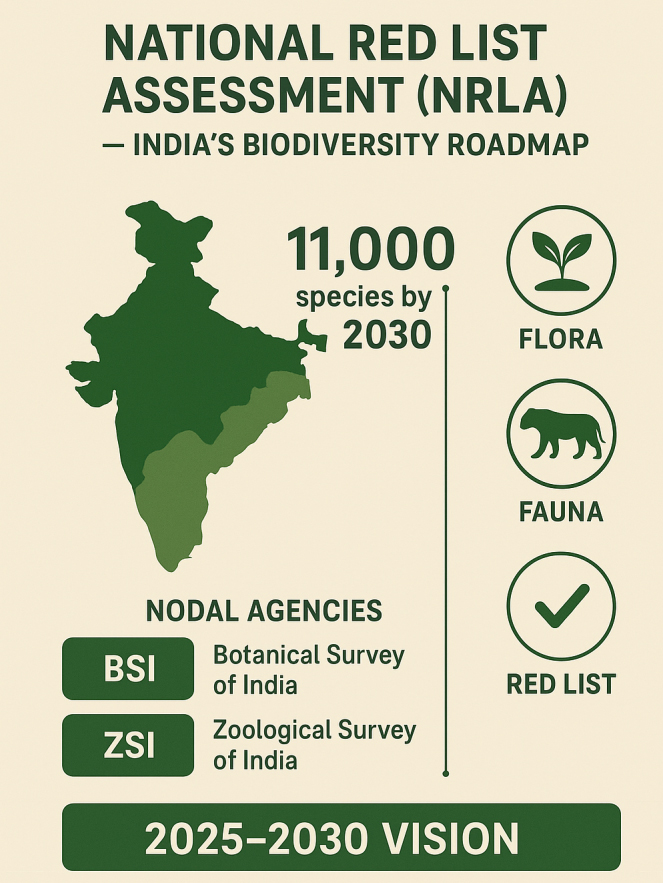Context:
Recently, Government of India launched National Red List Assessment (NRLA), aiming to evaluate the extinction risk of roughly 11,000 species (about 7,000 kinds of flora and 4,000 fauna). This will be done over the next five years (2025‑2030) at the IUCN World Conservation Congress held in Abu Dhabi. This marks India's first comprehensive, coordinated assessment of its biodiversity at this scale.
What the Assessment will do?
-
- The assessment will follow IUCN‑aligned scientific guidelines, ensuring that the methodology for classifying species into categories like Critically Endangered, Endangered, Vulnerable, Near Threatened etc. is consistent with international standards.
- By 2030, the goal is to publish National Red Data Books for flora and fauna, and maintain a living, upgradable Red List system. The initiative is part of India's commitment under international biodiversity mechanisms: the Convention on Biological Diversity (CBD) and the Kunming‑Montreal Global Biodiversity Framework (KM‑GBF).
- The assessment will follow IUCN‑aligned scientific guidelines, ensuring that the methodology for classifying species into categories like Critically Endangered, Endangered, Vulnerable, Near Threatened etc. is consistent with international standards.
Significance:
-
- India is one of the world’s megadiverse countries, harboring a very high number of species relative to its land area. Although it covers only about 2.4% of Earth's land area, it hosts nearly 8% of global plant species and about 7.5% of global animal species.
- A large share of India’s species are endemic . The drive to assess many species will help in identifying which of them are under threat, which are doing reasonably well, which lack data, and thereby guide conservation priorities.
- India is one of the world’s megadiverse countries, harboring a very high number of species relative to its land area. Although it covers only about 2.4% of Earth's land area, it hosts nearly 8% of global plant species and about 7.5% of global animal species.
Implications:
Globally, about 28% of species assessed under the IUCN Red List are regarded as threatened. India’s national list will add granularity for its rich biodiversity.
About Convention on Biological Diversity (CBD):
The CBD is an international treaty aimed at conserving the diversity of life on Earth. It was adopted during the 1992 Earth Summit in Rio de Janeiro and entered into force in 1993. The treaty has three main objectives:
1. Conservation of biological diversity: Protecting ecosystems, species, and genetic diversity.
2. Sustainable use of its components: Ensuring that the use of biological resources is sustainable.
3. Fair and equitable sharing of benefits: Sharing the benefits arising from the utilization of genetic resources fairly.
Kunming-Montreal Global Biodiversity Framework (GBF):
-
- The GBF is a global agreement adopted at the 15th Conference of the Parties (COP15) to the CBD in December 2022. It aims to halt and reverse biodiversity loss by 2050.
- India, as a Party to the CBD, is actively engaged in implementing the GBF. The country has initiated the National Red List Assessment to evaluate the extinction risk of approximately 11,000 species of flora and fauna. This initiative aligns with the GBF's targets and contributes to India's commitment to global biodiversity conservation efforts.
- The GBF is a global agreement adopted at the 15th Conference of the Parties (COP15) to the CBD in December 2022. It aims to halt and reverse biodiversity loss by 2050.
Conclusion:
India’s National Red List Assessment aims to assess 11,000 species in 5 years, aligning with global standards to better identify and protect vulnerable biodiversity. Its impact depends on reliable data, sustained funding, timely conservation action, and long-term updates beyond 2030.







